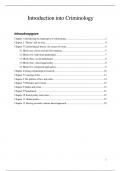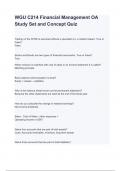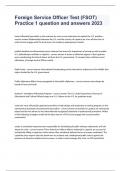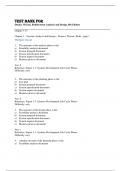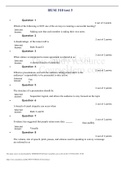Introduction into Criminology
Inhoudsopgave
Chapter 1 Introducing the landscapes of criminology................................................................2
Chapter 2 ‘Theory’ and its uses...................................................................................................4
Chapter 3 Criminological theory: the causes of crime................................................................6
3.1 Block one: choice and decision-making.......................................................................6
3.2 Block two: individual pathologies................................................................................7
3.3 Block three: social pathologies.....................................................................................8
3.4 Block four: critical approaches.....................................................................................8
3.5 Block five: integrated approaches.................................................................................9
Chapter 4 Doing criminological research.................................................................................10
Chapter 5 Counting crime.........................................................................................................12
Chapter 6 The politics of law and order....................................................................................14
Chapter 7 Offenders and victims...............................................................................................16
Chapter 8 Media and crime.......................................................................................................19
Chapter 9 Punishment...............................................................................................................21
Chapter 10 Social policy and crime..........................................................................................25
Chapter 11 Global justice..........................................................................................................27
Chapter 12 Moving towards a harms-based approach..............................................................29
1
,Chapter 1 Introducing the landscapes of criminology
Criminology is the study of crime, justice, and law and order issues, and the broader dynamics
of societies in terms of informing how those things exist and are experienced. Thus, the social
and cultural context, the political climate, the nature of the economy, processes such as
globalisation and technological progress, a human rights agenda, and so on, must also be
considered when seeking to explore and understand the nature of crime and justice.
Criminology is interdisciplinary in nature: as a field of study, it draws in the expertise and
knowledge of people working across many academic disciplines.
As a student, engaging in criminology requires a range of skills and competencies:
Finding appropriate materials: using ‘credible’ sources within your work is
important.
Using materials in an appropriate way: it is important to ask where it has come
from. Criminology is evidence-driven. This means that any claims or arguments need
to be supported by appropriate evidence.
Being a critical enquirer: this means approaching topics, arguments and sources of
material with a natural curiosity for what it tells us, but also what it does not tell us.
Being a reflective learner: this means actively stopping and taking stock of your own
learning, work, skills and skills gaps, and asking what has gone well and what has not
gone well.
Being a pragmatic researcher: this entails approaching issues using different
approaches and methods, and thus utilising the best tool for the job being undertaken.
Being digitally competent: increasingly, criminologists must engage with the digital
world.
Being an advocate for change: it is important to want to see positive change in some
way.
The nature of and the workings of criminal justice systems (CJS) is an important feature of
criminology. It is the process through which the state responds to behaviour that it deems
unacceptable. Criminal Justice is delivered through a series of stages: charge, prosecution,
trial, sentence, appeal, punishment, these processes and the agencies which carry them out are
referred to collectively as the criminal justice system.
A common-sense way of talking about crime often entails linking it to law, defining crime as
an intentional act which breaks or goes against a law of some sort. But, only seeing ‘crime’ in
that way is very limited. Criminologists point to a range of problems associated with this legal
definition. Questions that can be asked are: Where have laws come from, who creates them,
and for what purpose? Are some laws needless? Laws are also not fixed or static. New laws
can be made and old laws repealed. This means that what is understood to be ‘crime’ must
also be fluid. Also, the decision to criminalise certain behaviours has to be influenced by
something, such as pressure from the public, changing social attitudes, and technological
developments.
Many damaging behaviours are not criminalised, while some groups in society are seemingly
disadvantaged by the needless criminalisation of certain behaviours, such as homosexuality or
2
, abortion in some countries. Often, there is a moral component to how we understand
behaviours and whether they are viewed as being problematic. The socially constructed nature
of crime refers to how much of what is viewed as ‘crime’ is a product of the dynamics of a
given society at a given point in time. Deviancy describes acts that are outside the mainstream
values and norms of a society. In the harms-based approach, criminologists consider a range
of issues (e.g., working conditions or health damage) whereby there is clearly harm being
carried out against people and groups that demands some form of attention and action. The
more harm dome, the greater the severity of the response required.
Type of crime Description
Acquisitive crimes Acts that involve the ‘acquisition’ or gain of property, money or
anything else that is a tangible reward.
Expressive crimes Acts that do not, seemingly, involve the acquisition of goods,
but instead are linked to emotions and emotional release: anger,
frustration etc., where the act itself if the goal. They are often
violent or sexual in nature.
Property crimes Acts involving the acquisition of property or damage to
property.
Crimes against the Crimes that directly involve an act against an individual, or
person group of people.
Sexual offences Acts covering all manner of unwanted or inappropriate sexual
behaviours against a person, or group, physical or otherwise.
White-collar crime Acts committed by people usually in a work context, for their
own personal gain. It is offending in respectable or status-based
professions, as opposed to ‘blue-collar’ workers.
Corporate crime Acts committed by or on behalf of a company that in some way
benefits company goals.
Crimes of the powerful Acts committed by those in positions of ‘power’, where they
abuse their position of power and act with some form of
corruption and impunity.
State crimes Acts committed, commissioned or advocated in some way by
States to achieve their goals.
‘Peace crimes’, Acts that are so abhorrent or terrible that they go against
including crimes humanity, and thus have their own label, such as genocide and
against humanity systematic torture.
Social harms Linked to the ‘harms-based’ definition of crime. Acts that harm
communities or specific groups of people and are often not
dealt with by formal laws.
War crimes Acts committed during conflicts and wars, when State actors
breach domestic or usually international laws regarding
warfare, and involve a disregard for human rights.
Status offences/crimes Acts that are prohibited usually only for certain groups or in the
context of certain conditions. Often, this is in the instance of
young people having their behaviours regulated.
Hate crimes Acts committed where victims are targeted because of their
personal characteristics.
Cybercrime Acts committed using or facilitated by information and
communication technologies, typically the Internet.
3
Inhoudsopgave
Chapter 1 Introducing the landscapes of criminology................................................................2
Chapter 2 ‘Theory’ and its uses...................................................................................................4
Chapter 3 Criminological theory: the causes of crime................................................................6
3.1 Block one: choice and decision-making.......................................................................6
3.2 Block two: individual pathologies................................................................................7
3.3 Block three: social pathologies.....................................................................................8
3.4 Block four: critical approaches.....................................................................................8
3.5 Block five: integrated approaches.................................................................................9
Chapter 4 Doing criminological research.................................................................................10
Chapter 5 Counting crime.........................................................................................................12
Chapter 6 The politics of law and order....................................................................................14
Chapter 7 Offenders and victims...............................................................................................16
Chapter 8 Media and crime.......................................................................................................19
Chapter 9 Punishment...............................................................................................................21
Chapter 10 Social policy and crime..........................................................................................25
Chapter 11 Global justice..........................................................................................................27
Chapter 12 Moving towards a harms-based approach..............................................................29
1
,Chapter 1 Introducing the landscapes of criminology
Criminology is the study of crime, justice, and law and order issues, and the broader dynamics
of societies in terms of informing how those things exist and are experienced. Thus, the social
and cultural context, the political climate, the nature of the economy, processes such as
globalisation and technological progress, a human rights agenda, and so on, must also be
considered when seeking to explore and understand the nature of crime and justice.
Criminology is interdisciplinary in nature: as a field of study, it draws in the expertise and
knowledge of people working across many academic disciplines.
As a student, engaging in criminology requires a range of skills and competencies:
Finding appropriate materials: using ‘credible’ sources within your work is
important.
Using materials in an appropriate way: it is important to ask where it has come
from. Criminology is evidence-driven. This means that any claims or arguments need
to be supported by appropriate evidence.
Being a critical enquirer: this means approaching topics, arguments and sources of
material with a natural curiosity for what it tells us, but also what it does not tell us.
Being a reflective learner: this means actively stopping and taking stock of your own
learning, work, skills and skills gaps, and asking what has gone well and what has not
gone well.
Being a pragmatic researcher: this entails approaching issues using different
approaches and methods, and thus utilising the best tool for the job being undertaken.
Being digitally competent: increasingly, criminologists must engage with the digital
world.
Being an advocate for change: it is important to want to see positive change in some
way.
The nature of and the workings of criminal justice systems (CJS) is an important feature of
criminology. It is the process through which the state responds to behaviour that it deems
unacceptable. Criminal Justice is delivered through a series of stages: charge, prosecution,
trial, sentence, appeal, punishment, these processes and the agencies which carry them out are
referred to collectively as the criminal justice system.
A common-sense way of talking about crime often entails linking it to law, defining crime as
an intentional act which breaks or goes against a law of some sort. But, only seeing ‘crime’ in
that way is very limited. Criminologists point to a range of problems associated with this legal
definition. Questions that can be asked are: Where have laws come from, who creates them,
and for what purpose? Are some laws needless? Laws are also not fixed or static. New laws
can be made and old laws repealed. This means that what is understood to be ‘crime’ must
also be fluid. Also, the decision to criminalise certain behaviours has to be influenced by
something, such as pressure from the public, changing social attitudes, and technological
developments.
Many damaging behaviours are not criminalised, while some groups in society are seemingly
disadvantaged by the needless criminalisation of certain behaviours, such as homosexuality or
2
, abortion in some countries. Often, there is a moral component to how we understand
behaviours and whether they are viewed as being problematic. The socially constructed nature
of crime refers to how much of what is viewed as ‘crime’ is a product of the dynamics of a
given society at a given point in time. Deviancy describes acts that are outside the mainstream
values and norms of a society. In the harms-based approach, criminologists consider a range
of issues (e.g., working conditions or health damage) whereby there is clearly harm being
carried out against people and groups that demands some form of attention and action. The
more harm dome, the greater the severity of the response required.
Type of crime Description
Acquisitive crimes Acts that involve the ‘acquisition’ or gain of property, money or
anything else that is a tangible reward.
Expressive crimes Acts that do not, seemingly, involve the acquisition of goods,
but instead are linked to emotions and emotional release: anger,
frustration etc., where the act itself if the goal. They are often
violent or sexual in nature.
Property crimes Acts involving the acquisition of property or damage to
property.
Crimes against the Crimes that directly involve an act against an individual, or
person group of people.
Sexual offences Acts covering all manner of unwanted or inappropriate sexual
behaviours against a person, or group, physical or otherwise.
White-collar crime Acts committed by people usually in a work context, for their
own personal gain. It is offending in respectable or status-based
professions, as opposed to ‘blue-collar’ workers.
Corporate crime Acts committed by or on behalf of a company that in some way
benefits company goals.
Crimes of the powerful Acts committed by those in positions of ‘power’, where they
abuse their position of power and act with some form of
corruption and impunity.
State crimes Acts committed, commissioned or advocated in some way by
States to achieve their goals.
‘Peace crimes’, Acts that are so abhorrent or terrible that they go against
including crimes humanity, and thus have their own label, such as genocide and
against humanity systematic torture.
Social harms Linked to the ‘harms-based’ definition of crime. Acts that harm
communities or specific groups of people and are often not
dealt with by formal laws.
War crimes Acts committed during conflicts and wars, when State actors
breach domestic or usually international laws regarding
warfare, and involve a disregard for human rights.
Status offences/crimes Acts that are prohibited usually only for certain groups or in the
context of certain conditions. Often, this is in the instance of
young people having their behaviours regulated.
Hate crimes Acts committed where victims are targeted because of their
personal characteristics.
Cybercrime Acts committed using or facilitated by information and
communication technologies, typically the Internet.
3


